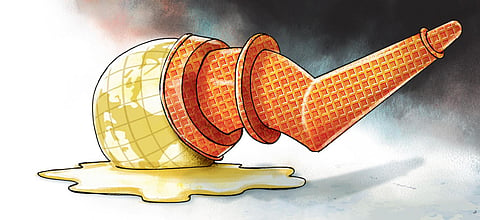

The economic fallout from the Covid-19 pandemic has been swift, global and simultaneous. We hear that “this time, it’s different” every time a macro correction occurs, and this time it truly may be so. The 1999 and 2008 crises were certainly high impact, but neither was as global as the 2020 correction that was felt in every nation due to the first simultaneous worldwide lockdown in the modern economic world order. The IMF estimates that the $82 trillion global economy may shrink by 3-4%, implying a loss of around $3 trillion. Downward revisions of most advanced nations’ GDP growth rates for 2020 are already showing recessionary signals.
The response by global governments has been equally swift and intense. The IMF estimates that approximately $9 trillion has been announced as a combination of fiscal and monetary stimulus across the world. The US, Japan and Germany, among other nations, have given trillions in stimulus packages to stabilise their economies. The increase in money supply should raise inflation and possibly drive down interest rates to negative zones. There has been a sharp decline in central bank rates in the G7, with the US at 0.25%, UK at 0.1%, Japan at -0.1%, and the ECB MDR at -0.5%.
Jobs worldwide have been a significant casualty of this correction. For the first time since the Great Depression, the US witnessed a 23.6% real jobless rate. Over 40.8 million Americans filed for unemployment over the past few months. Bedrock verticals and large employment segments like travel, hospitality, manufacturing, leisure and tourism, retail, food and beverages, events, entertainment, and mobility were offline amidst lockdowns in almost every country that was touched by the pandemic. While employment should recover steadily, it may take much longer than anticipated to go back to the record low unemployment levels seen in most advanced economies before Covid-19.
It is not hard to see a more permanent refactoring of jobs being accelerated by the predictable changes that will need to be implemented, such as work from home, masks, temperature checks, social distancing, and other behavioural shifts. The call for upskilling and future readiness will threaten middle income jobs in the services industries particularly, and this will serve as a significant challenge for governments to address.
The pandemic has also uncovered an obvious vulnerability of the global economy—the overdependence of its supply chains on China. China contributes approximately 24% of global manufacturing and amongst the largest shares of the pharmaceutical supply market. With its perceived coercive influence across economies even before the crisis, the build-up of distrust in the CCP’s expansive strategies burst through the headlines globally. Japan’s government announced support of over $2.2 billion to help its nation’s companies shift their supply chains out of China. India announced new controls on capital investments from China into the country. The UK has made it a national priority to move off its reliance on Chinese imports. The US has escalated tensions with renewed calls for economic decoupling. This shift of global supply chains will open new opportunities for India and other emerging Asian economies to capture.
The impact on the Indian economy is undoubtedly unprecedented. The economy was at a standstill with the nationwide shutdown. While the mass compliance with the PM’s decisions was an impressive achievement of a united and cooperative citizenry in the interest of community health, the economic fallout will be an equally daunting challenge to meet. For the first time in a generation, not a single personal car was sold in a month’s time and approximately 3 crore people were estimated to miss monthly salaries. The $3 trillion Indian economy may lose approximately $30 billion in size, witnessing negative growth for the first time since Independence. In addition, there may be negative inflation with deeply dampened demand.
To its credit, the Centre has grabbed this opportunity to pass massive reforms that have been long pending. It has rapidly deregulated large-scale industries such as coal and minerals mining, defence manufacturing, civil aviation, power distribution, space sector, atomic energy, solar and battery manufacturing. The amendments to the Essential Commodities Act, including market linkages, pricing
elasticity of agri production and infrastructure development for animal husbandry, will rapidly formalise the food production efficiency and earning power of farmers.
The Reserve Bank has reduced interest rates and infused liquidity to stabilise the economy. The Centre has delivered large-scale relief packages to the poor and set a global precedent in using technology to do so. It has announced a significant stimulus package for MSMEs to revive economic activity by the third quarter. There is plenty more to do to realign the economy to its $5 trillion GDP target. The Union government must also devise a large reconstruction budget to build infrastructure and lift the economy.
It must do much more to support labour intensive industries such as textiles, chemicals and pharmaceuticals, electronics assembly, automobile manufacturing, and more. It must also accelerate its support to cleaning up the real estate industry and reignite construction work across the nation—this sector alone accounts for over 1.7 crore people employed.
We must view this as a generational opportunity to systematically realign the rails of New India. Decisive steps taken now will drive our economic trajectory for the next decade. As a nation, we cannot miss this window to aggressively capture our position in a realigning world order.
TV Mohandas Pai
Chairman,3one4 Capital
Pranav Pai
Partner,3one4 Capital
(Tweets @TVMohandasPai and @Pai_dPiper)